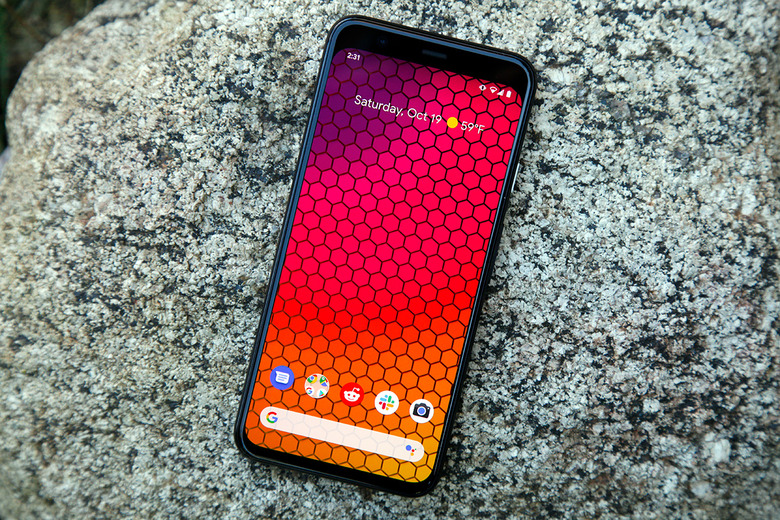Pixel 5 Might Not Get The Pixel 4's Most Innovative Feature
- The upcoming Pixel 5 flagship will ditch Google's proprietary radar technology introduced last year, a new leak says.
- The Pixel 4 is the only handset in the world to feature a radar chip that can detect hand gestures and movement.
- However, the Soli-powered Motion Sense is more of a gimmick than a must-have smartphone feature, and it ruins the Pixel 4's screen design.
- Visit BGR's homepage for more stories.
Google announced several Pixel 4 features several months before the phone itself was revealed, including the dual-lens rear camera design and the 3D face recognition system on the front, powered by the Project Soli radar chip. That Soli radar chip forced Google to use an all-screen design unlike anything ever seen on an Android phone. The Pixel 4 got a couple of large asymmetric bezels, with the top one being especially ugly. That's because Google had to place all of the selfie camera components that make 3D face recognition possible and the Soli chip inside that bezel. Therefore, a notch design like the iPhone X or a hole-punch display like the Galaxy S10 wasn't possible.
Once the Pixel 4 was unveiled, we learned just how sophisticated the entire Motion Sense system was. It's also pretty much useless, as it offers limited benefits for Face unlock and limited touchless control of the handset. So, it's no surprise to hear that Google is considering ditching Motion Sense on the Pixel 5.
Make no mistake, placing a radar chip inside a phone is no small feat. This type of feature could one day pave the way for interaction with a smart device via touch like the one imagined in Minority Report. Radar might not be used just on smartphones, but also on computers and wearable devices to detect hand presence and interpret gestures. That's assuming Google has such plans for the technology. Aside from Pixel 4, no Android handset or iPhone have similar technology available, though LG attempted a similar functionality using Time of Flight (ToF) camera tech instead of radar last year.
But the massive downside of Motion Sense is that it takes up too much space on the front of the display. Motion Sense is a gimmick at best on Pixel 4, one that even Google struggles to defend. Well-known leaker Jon Prosser offered the following Pixel 5 render several months ago that seemed to indicate Motion Sense was very much in the picture, albeit the Pixel 5 design below features a much smaller bezel:
Prototype Pixel 5 render, front and back.
Forehead is slightly smaller than Pixel 4 – still giving room for the Soli Radar system.
I still hope this isn't the final design.
Think it looks better in white? pic.twitter.com/lOtQkyY5fY
— jon prosser (@jon_prosser) February 20, 2020
Fast-forward to mid-May and 9to5Google's Stephen Hall says that sources have revealed additional details about the Pixel 5, including the fact that it will "likely leave behind hobbies like Soli."
Ditching Motion Sense will not hurt the phone's 3D face recognition capabilities. With Soli, Google argues that its Face Unlock works even faster than Face ID because it detects the user's intention via radar. But how much time are you really saving? As for touchless interaction, Google might have an idea of how many people wave their hands in front of their phone to perform any of the limited tasks that Motion Sense can deliver. I'd venture to guess not many people use it as often as Google would have liked, and that very few people will miss it.
Pixel 4a render based on leaks and rumors.
The Pixel 5 is already rumored to be a mid-range 5G phone, as Google will supposedly use the Snapdragon 765G processor instead of the Snapdragon 865 that powers the Galaxy S20 and OnePlus 8. Add Motion Sense to it, and you end up with a phone that can't match those two flagships, or the iPhone 12, when it comes to specs and design. Put it differently, the Pixel 4a's rumored hole-punch design looks much better than the Pixel 4, and that would be one reason to choose it instead of the 2020 iPhone SE. The new iPhone will mop the floor with the Pixel 4a when it comes to performance, but it does have big top and bottom bezels that don't fit the current trends.
The Pixel 5 will have a much better build quality than the Pixel 4a and will deliver an experience closer to other premium handsets. And without Motion Sense, maybe Google could bring a much better screen-to-body ratio to the table. A better design would make the Pixel 5 more appealing, regardless of its specifications.
These are all rumors, of course, but as we get closer to fall, the Pixel 5's final design and full specs sheet will probably leak well before Google's Pixel 5 reveal event.
